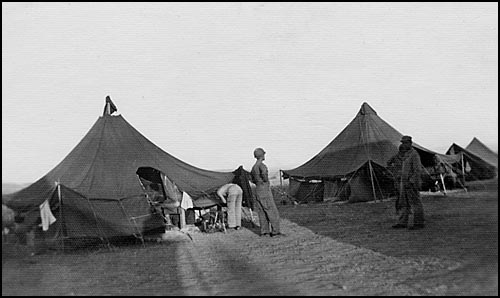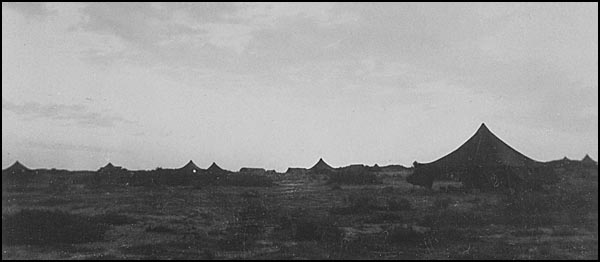June 1943
|
6-8 Jun 1943 |
Nouvion
Airfield, Algeria. Bivouacked in an olive orchard 400 miles SE of Blida.
Flying training missions in tight formations with the US 82nd Airborne
Division; British and French airborne units. The squadron is sent TDY to
Oujda Airdrome, French Morocco, 600 miles SW of Blida |
|||
|
|
|
|||
|
8-17 Jun 1943 |
Oujda
Airdrome, French Morocco. The entire group is bivouacked in the desert close to
our aircraft. Intensive squadron and group night formations and paradrops.
Following one of these night drops, one paratrooper told me that his "stick"
was floating near a river that was shining in the moonlight. All of the
troopers unfastened their harnesses and dropped twenty feet into the
water-that turned out to be a wet runway! Broken bones all over the
place! During the final mass formation dress rehearsal for a future mission,
we were experimenting with two-ship formation take-offs. My ship was on the
right wing of the leader. As power was applied, and we sped off into the
darkness, we became enveloped in a dust cloud that cut visibility to zero. I
was standing beside my crew chief, T/Sgt. Robert Bramble, behind the cockpit.
Every eye strained to see the leader. The next thing we saw was a line of
C-47s taxiing into take-off position, and behind them the dark silhouette of
a hangar. In desperation, the pilot yanked back on the yoke, and we staggered
into the air, missing the top of the hangar by inches! Who said that a loaded
C-47 won't fly at 60 MPH? Everyone was "shook" by our brush with
disaster, which was evidenced when the pilot said to Bramble, "I don't
know why, but I can't get any speed out of this bird!" Bob laconically
replied, "It might help, if we were to pull up the gear!" It was a
bad night all the way around. When we reached the drop zone and gave the
troopers the green light, the anti-tank gun they attempted to shove out the
door became jammed. Paratroopers hate to fly, and all were prepared to climb
over the gun to get out, but the jumpmaster would have none of it. He drew
his .45 pistol, and threatened to shoot anyone who tried! A stick of unhappy
troopers were brought back to base. The squadron is ordered back to Nouvion
the following day |
|||
|
|
|
|||
|
17-27 Jun 1943 |
Nouvion
Airfield, Algeria. Night formation proficiency and paradrops continue. During
our latter days at Nouvion, the squadron airlifts troops and equipment from
rear areas to invasion departure points in Algeria and Tunisia. We are
ordered to Kairouan, Tunisia, 150 miles south of Tunis. |
|||
|
|
|
|||
|
|
|
Nouvion Airstrip, Algeria. Corporal Tommie Chitwood at
center. June 1943. (Photo and caption by James A. Moran, RO, 17th TCS. |
|
|
|
|
|
|||
|
6-27/7-3 1943 |
Zena-One Airstrip (Later
designated "Q-Strip"), Tunisia. Bivouacked
in the Sahara on one of the many satellite strips surrounding the Muslim holy
city of Kairouan (Arabic Al Qayrawan) . Our sister squadrons are at similar
strips. Training missions continue for an airborne assault on an as yet
unidentified target; Sardinia, Sicily or Greece. Due to the intensive heat
that is near or above 120 degrees, flying is done in the early morning hours,
or at night. Temperatures reach 175 inside the ships, and we can work inside
only a few minutes at a time. After
pitching our tent the first night, an ugly black scorpion crawls out of my
bunk, which is a litter from the ship, and low on the ground. That did it! I
hustled out to the ship to join Bramble, whose night it was to remain aboard.
We sat in the cockpit, smoking our cigarettes, and trying to tune in to the
German propaganda station on the radio compass. Moments later, we hear Axis
Sally-welcoming the 64th Troop Carrier Group to Kairouan, and sweetly saying
that she hopes we will learn to love the desert, as our bones are destined to
remain their forever! We
loved to listen to this station as it always played the latest records from
home. Heck, Sally knew more about our operations than we did! On 6-29-43, the
National Insignia underwent its second change, when a white rectangle was
added to either side of the star, the entirety being bordered in red. NOTE: The insignia
had an earlier, unofficial, change after we reached North Africa. Following
the RAF, a yellow ring was painted around the star on most of our aircraft;
some even added the RAF fin flash on the rudder, but this was strictly
optional. |
|||
|
|
|
|||
|
|
|
"B" Strip, El Djem, Tunisia. Sunset in the Sahara. July
1943. (Photo and caption by James A. Moran. |
|
|
|
|
|
|||
|
|
||||

